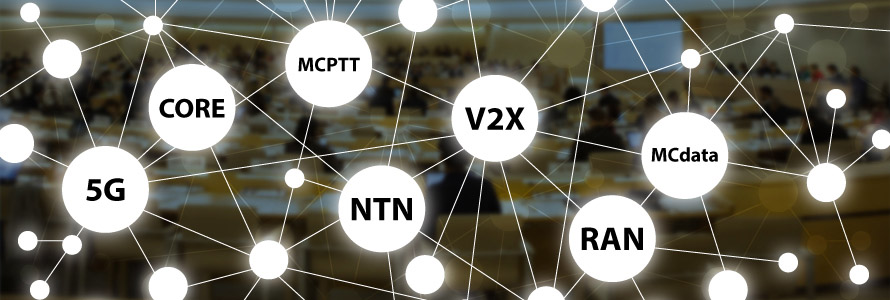This blog is a repost from MissionCritical Communications magazine, originally published on October 19, 2021.
This blog post is part of the "Tech Talk" series focused on the First Responder Network Authority’s (FirstNet Authority) standards development activities to support public safety. This post recaps discussions linked to public safety and other related topics from the 3GPP Plenary meetings that were conducted online September 13-20, 2021. The FirstNet Authority represented public safety interests at the plenary meetings.
The third-quarterly Third Generation Partnership Project (3GPP) Plenary e-meetings of 2021 recently concluded. Participants spent considerable time on preliminary scoping of the Release 18 (R18) feature content and schedule.
At the same time, delegates made good progress on the stage 3 (protocol) work for Release 17 (R17). Currently, the R17 stage 3 freeze date remains on schedule for March. During the meetings, the R18 schedule discussion ended with an initial agreement on an 18‑month timeline which would result in a December 2023 completion target date. A final decision on the content will be made during the December 2021 Plenary e‑meetings.
Given the uncertainties caused by COVID-19 variants and vaccine requirements of various countries, participants discussed and agreed to extend the e‑meeting format through February 2022. In December 2021, 3GPP will address restarting face-to-face meetings in March. Despite the lack of face-to-face discussions, the number of approved changes to the specifications, as a metric of 3GPP progress, continues to increase.
Two workshops were held to begin the scoping process for R18. A Technical Specification Group (TSG) Radio Access Network (RAN) workshop was held from June 28 to July 2, and a TSG Service and System Aspects (SA) workshop was held on September 9-10. The RAN workshop concentrated on radio aspects, while the SA workshop focused on architectural aspects. The output of these two workshops fed into the further discussion in 3GPP Plenary meetings, including a joint meeting of all 3GPP TSGs to shape the candidate list of features. The First Responder Network Authority (FirstNet Authority) provided input into each workshop with the support of AT&T and multiple international public safety partners.
The following TSG reports include details on each of the Plenary TSG meetings with a focus on the progress on features important to public safety. Participation continues to include representatives from nearly all major mobile equipment vendors, chip manufacturers, software vendors, and network operators from about 35 countries. The FirstNet Authority was joined by government agencies from other nations continue to represent public safety interests.
The Radio Access Network (RAN) Plenary
There were 997 registrants for the TSG RAN September Plenary meeting. RAN is responsible for defining the functions, requirements, and interfaces of the 3GPP radio network.
During the RAN workshop, the FirstNet Authority submitted a paper entitled “Public Safety Requirements for Release 18.” With guidance from the RAN chair, the FirstNet Authority led the focused discussion on these topics and provided an email summary contribution to the 3GPP community.
Delegates discussed potential R18 topics including several of interest to public safety. Sidelink enhancements are being proposed to increase coverage with the use of multi-hop connectivity between devices. The enhancements to location services are intended to improve positioning in all dimensions including accuracy. Ranging services would provide direction and distance to another device in support of situational awareness. Support of reduced capacity (RedCap) devices would include enhancements to their capabilities. The proposed work on non-terrestrial networks (NTN), such as satellites, is targeted at support for voice calls, broadcast services, and positioning determination. Evolution of 5G multicast-broadcast services (5MBS) would further improve radio resource efficiencies. Continued work on uncrewed aerial vehicles would aid the operation of drones. And finally, participants discussed another public safety priority, vehicle mounted relays (VMRs) operating as mobile base stations that would extend 5G coverage in a variety of mobile and stationary scenarios. Discussion of these topics will continue through the December plenary meetings where final decisions will be made on R18 content.
Working group chairs reported good progress on R17 features. All normative specifications work (stage three) is on schedule for completion by March. R17 radio-based features of interest to public safety include the 5G New Radio (NR) positioning enhancements and NR sidelink enhancements including relay. The sidelink provides the direct mode communications between devices. Support for the L, Ka and Ku bands has been defined for satellite (NTN) operators to use for extending coverage, particularly in remote areas. Finally, the use of NR multicast and broadcast services will support communications to large groups of first responders while reducing the radio resources.
The SA Plenary
There were 427 registrants for the TSG SA September Plenary meeting, which is responsible for the overall architecture and service capabilities of 3GPP-based systems. The group pursued its primary focus of progressing R17 architecture specifications and R18 requirements while continuing the R18 scope discussion that began during the R18 workshops.
As input to the SA workshop, the FirstNet Authority presented a multinational view of R18 high- priority features for public safety. Most of the high priority topics discussed during the RAN plenary require SA development work, but there are specific SA-only R18 topics of interest to public safety such as enhancement of Mission Critical (MC) services over 5G.
The SA1 working group submitted requirements for a significant new R18 feature: ad hoc group communication. The plenary approved the requirements to be added to the MC specifications. The ad hoc group communication feature will allow authorized users to make a group call to a set of users based on implementation-specific criteria (e.g., proximity, selected from contacts) without first configuring the group in the group management server. Although initially discussed and excluded from the MC specifications, interest around the world has grown in the last few years to add this capability.
In other areas, new requirements for administration configuration between interconnected MC systems were added. The ability to share MC administration configuration information between MC systems can reduce overhead and support mutual aid scenarios. Finally, participants finalized requirements for VMR, (i.e., mobile base station relays). VMR is another solution that can be leveraged for improved public safety coverage in various scenarios.
The SA2 working group reported to the plenary that most technical specifications of interest to public safety for R17 have been completed. Some exceptions were granted where additional information is required from RAN working groups and the SA3 security group. Progress in SA2 architecture technical specification work will allow the Core Network and Terminals (CT) working groups to continue their stage three efforts.
SA2 declared the architectural technical specifications for 5G Proximity Services (5G ProSe) at 98% completion and for 5G Multicast Broadcast Services (5MBS) at 85% completion. The progress of both 5G ProSe and 5MBS in R17 is key to enable the SA6 working group to complete technical specifications work on MC services over 5G to support these features.
SA3 continues to work on the security aspects of R17 features ranging from ProSe to MC services over 5G. The normal operation of SA3 is to progress both security study topics and normative work as much as possible within the time frame of a release. Features and solutions that are not complete are then carried over into the next release. It is expected that this same procedure will be used to move unfinished security items from R17 to R18.
The study phase of security for 5G ProSe is complete. The results of this study will be employed to complete the security functionality required by the work specified by other 3GPP working groups for their parts of the 5G ProSe feature. Normative work to provide security for ProSe services has begun, with substantial progress expected by December. Support for a 256-bit cryptographic in 5G. algorithm support is expected to progress in R18 with European Telecommunications Standards Institute (ETSI) Sage continuing work on specifying algorithms that meet SA3 requirements. This process of algorithm specification is laying the groundwork for potential inclusion of 256-bit cryptographic algorithms in 5G.
The SA6 working group reported that architectural work continued for MC services over 5G. A study that includes the off-network and multicast aspects made good progress as details emerged for the main 5G MC enablers – sidelink and 5MBS. The plan is to complete the stage two work on MC services over 5G in R18. In other areas, a R18 architectural study for a new function called the MC Gateway user equipment (UE) was completed. The gateway is designed to connect various devices hosting MC clients to the 3GPP system using non-3GPP interfaces (e.g., Bluetooth, WiFi). A new work item to finalize the architectural design for the gateway function was also approved.
The CT Plenary
There were 196 registrants for the TSG CT September Plenary meeting, which covers the protocol details that follow the requirements and architectural work performed in the SA TSG. The meeting made good progress on R17 features of special interest to public safety.
Enhancements completed so far in R17 for mission-critical push to talk (MCPTT), mission-critical data (MCData) and mission-critical video (MCVideo) include preconfigured regrouping and improvements to message exchange, storage and retrieval. Some rescoping is expected for the R17 work plan on MCPTT to match the level of stage two architectural work accomplished for R17. Significant progress on a cleanup of the MCVideo protocol has been achieved, going back to R14. More cleanup is planned for October and November to achieve a significantly more stable set of MCVideo specifications.
Enhancements to the interworking of MCPTT and MCData with LMR systems (MCCI-CT) to support regrouping are expected to be in scope in R18. The 3GPP MCCI-CT work needs to wait on the corresponding standards work for Project 25 (P25) LMR systems that do not yet support regrouping across inter-system interfaces.
Work on 5G proximity services was estimated at 65% completion. This work will support vehicle to anything (V2X), as well as direct mode connections for public safety. Work continues in other parts of 3GPP to enhance the radio sidelink to make this feature more usable in mission- critical situations.
Work continues for resolving issues identified by ETSI Plugtest events. Several issues have been resolved in the last quarter. The FirstNet Authority continues to act as a focal point for issues found in ETSI Plugtest events and their resolution. The FirstNet Authority also makes technical changes needed by the RAN5 working group as it defines the testing procedures for 3GPP mission-critical protocols.
Further information on the 3GPP’s work and organization can be found at: www.3gpp.org.




















